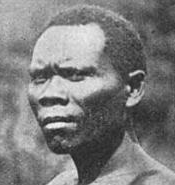Semang
|
| |
| Total population | |
|---|---|
| (c. 4596) | |
| Regions with significant populations | |
| 4296 | |
| 300[1] | |
| Languages | |
| Batek, Lanoh, Jahai, Mendriq, Mintil, Kensiu, Kintaq, Ten'edn, Malay | |
| Religion | |
| Animism and significant adherents of Islam, Christianity or Buddhism. | |
| Related ethnic groups | |
| Australoids (especially Negritos), Orang Asli | |
The Semang are a Negrito ethnic group of the Malay Peninsula. They are found in Perak, Kedah and Pahang of Malaysia.[2] During the colonial British administration, Orang Asli living in the northern Malay Peninsula were classified as Sakai.[3]
Lowland Semang tribes are also known as Sakai, although this term is considered to be derogatory by the Semang people.[4] They have been recorded to have lived here since before the 3rd century. They are ethnologically described as nomadic hunter-gatherers. See also Bajaus and Aetas.[5]
Semang Ethnic Groups
Orang Asli ethnic groups that are classified as "Semang" by the Malaysian government.
- Batek people
- Lanoh people
- Jahai people
- Mani people
- Kensiu people
- Kintaq people
- Mendriq people
Culture

The Semangs live in caves or leaf-shelters that form between branches. A loincloth for the men, made of tree bark hammered out with a wooden mallet from the bark of the terap, a species of wild bread-fruit tree, and a short skirt of the same material for the women decorated with segments of bamboo in patterns to magically protect its wearer from disease, is the only dress worn;[6] some go naked.
Scarification is practised.[7] Young boys and girls are scarified in a simple ritual to mark the end of their adolescence.[8] The finely serrated edge of a sugarcane leaf is drawn across the skin, then charcoal powder rubbed into the cut.[9]
They have bamboo musical instruments, a kind of jaw harp, and a nose flute.[10] On festive occasions, there is song and dance, both sexes decorating themselves with leaves.
The Semang bury their dead on the same day itself with the corpse wrapped in mat and the personal belonging of the deceased kept in a small bamboo rack placed over the grave.[11] It is only people of importance such as chief or great magicians are given tree burial.[12]
They have used Capnomancy (divination by smoke) to determine whether a camp is safe for the night.[13]
In 1906 the Thai King Chulalongkorn adopted a Semang orphan boy named Khanung.[14]
See also
References
- ↑ "Kensiu in Thailand". Joshua Project. Retrieved 2016-11-10.
- ↑ Nik Hassan Shuhaimi Nik Abdul Rahman (1998). The Encyclopedia of Malaysia: Early History, Volume 4. Archipelago Press. ISBN 981-3018-42-9.
- ↑ Ooi Keat Gin (2009). Historical Dictionary of Malaysia. Scarecrow Press. ISBN 0-8108-6305-7.
- ↑ Hajek, John (June 1996). "Unraveling Lowland Semang". Oceanic Linguistics. 35 (1): 138–141. doi:10.2307/3623034. JSTOR 3623034.
- ↑ Fix, Alan G. (June 1995). "Malayan Paleosociology: Implications for Patterns of Genetic Variation among the Orang Asli". American Anthropologist, New Series. 97 (2): 313–323. doi:10.1525/aa.1995.97.2.02a00090. JSTOR 681964.
- ↑ C. Daryll Forde (2013). Habitat, Economy and Society: A Geographical Introduction to Ethnology. Routledge. ISBN 113-6534-65-2.
- ↑ Wilfrid Dyson Hambly (1925). The History of Tattooing. Courier Corporation. ISBN 048-6468-12-7.
- ↑ Julian Haynes Steward (1972). Theory of Culture Change: The Methodology of Multilinear Evolution. University of Illinois Press. ISBN 025-2002-95-4.
- ↑ Alan Caillou (2000). Rampage. iUniverse. ISBN 059-5091-43-1.
- ↑ Terry Miller & Sean Williams, ed. (2011). The Garland Handbook of Southeast Asian Music. Routledge. ISBN 113-5901-54-6.
- ↑ Joachim Schliesinger (2015). Ethnic Groups of Thailand: Non-Tai-Speaking Peoples. Booksmango. ISBN 163-3232-29-8.
- ↑ Robert W. Williamson (2010). The Mafulu Mountain People of British New Guinea. Lulu.com. ISBN 140-9226-52-2.
- ↑ Scott Cunningham (2003). Divination for Beginners: Reading the Past, Present & Future. Llewellyn Publications. ISBN 073-8703-84-2.
- ↑ Woodhouse, Leslie (Spring 2012). "Concubines with Cameras: Royal Siamese Consorts Picturing Femininity and Ethnic Difference in Early 20th Century Siam". Women's Camera Work: Asia. 2 (2). Retrieved 8 July 2015.
Further reading
- Bernatzik, H. A., & Ivanoff, J. (2005). Moken and Semang: 1936–2004, persistence and change. Bangkok: White Lotus. ISBN 974-480-082-8
- Gomes, A. G. (1982). Ecological adaptation and population change: Semang foragers and Temuan horticulturists in West Malaysia. Honolulu, Hawaii (1777 East-West Rd., Honolulu 96848): East-West Environment and Policy Institute.
- Human Relations Area Files, inc. (1976). Semang. [Ann Arbor, Mich: University Microfilms.
- Mirante, Edith (2014) "The Wind in the Bamboo: Journeys in Search of Asia's 'Negrito' Indigenous Peoples" Bangkok, Orchid Press.
- Rambo, A. T. (1985). Primitive polluters: Semang impact on the Malaysian tropical rain forest ecosystem. Ann Arbor, Mich: Museum of Anthropology, University of Michigan. ISBN 0-915703-04-1
External links
| Wikimedia Commons has media related to Malay Peninsula negrito. |
-
 "Semang". New International Encyclopedia. 1905.
"Semang". New International Encyclopedia. 1905.
_(14781589525).jpg)